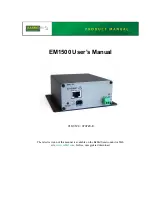
17
Installation
Gain Control
The front of module gain control can be adjusted via two methods
both of which require a known input level. One method requires
the use of a known calibrated digital waveform monitor to
observe the serial digital output. An alternate method requires the
use of an oscilloscope to observe a calibration adjustment
waveform generated by the 8301A-K.
To adjust the gain control with a calibrated waveform monitor the
key video source should be set to produce a full level output. If the
key video source has black level setup, the input format switch
should be placed in Position 7 and the black level control must be
adjusted first to correctly set the black level as observed on the
waveform monitor Y channel. The gain control is then adjusted to
produce correct peak white level as observed on the waveform
monitor. If the key signal does not contain setup, the input format
switch should be placed in Position 6 and only the gain control
need be adjusted to correctly set the white level as observed on the
waveform monitor Y channel.
Use of the calibration waveform created by the 8301A-K to adjust
gain has the advantage that calibrated external equipment is not
required. The calibration waveform created by the module
contains digitally-generated reference levels which makes
accurate gain calibration of the oscilloscope used unimportant. A
100% level input is required. Two front-of-module test points are
provided to allow adjustment of the gain and (optionally) black
level controls to create a correct digital output level. The rising
edge of the waveform at TRIGGER test point TP1 can be used as
an oscilloscope trigger source. The waveform at GAIN CAL test
point TP24 should be observed on the oscilloscope at a sweep
speed of 20µs/div and a gain of 500mV/div.
The calibration waveform consists of a four video line sequence. It
starts with a line which contains the upper 1/4 of the 10 bit Y
channel dynamic range and a 100% peak reference level. The next
two lines are unused for the 8301A-K version of the module. A
fourth line contains the lower 1/4 of the Y channel 10 bit dynamic
range and a black reference level. This fourth line does not need to
be observed unless the key input video has black level setup.









































